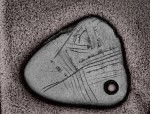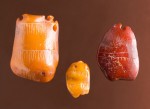 Archaeologists excavating the Early Mesolithic site of Star Carr in Yorkshire have unearthed a shale pendant with engraved lines. This is the first pendant with an engraved design from this period found in Britain and it’s the only engraved pendant made of shale ever discovered in Europe. It was found in a sediment layer that was once shallow water about 30 feet from the shore of the paleo-Lake Flixton. The organic material in the sediment is still being dated, but preliminary estimates date the sediment deposit to around 11,000 years ago.
Archaeologists excavating the Early Mesolithic site of Star Carr in Yorkshire have unearthed a shale pendant with engraved lines. This is the first pendant with an engraved design from this period found in Britain and it’s the only engraved pendant made of shale ever discovered in Europe. It was found in a sediment layer that was once shallow water about 30 feet from the shore of the paleo-Lake Flixton. The organic material in the sediment is still being dated, but preliminary estimates date the sediment deposit to around 11,000 years ago.
When it was first discovered it just looked like a piece of stone. The hole that marks it as a pendant was clogged with sediment and the very faint engravings weren’t visible. It was only when it was lifted out of the ground that the sediment fell out of the perforation and the engravings were spotted.
 Just one side of the shale is engraved with very small lines at angles from each other of a kind defined by the first excavator of Star Carr and expert in Early Mesolithic art Grahame Clark as the barbed lines type C. They were incised on the stone. Incision was the most common method of Early Mesolithic engraving (as opposed to boring and drilling) and geometric designs engraved on portable objects were typical of the period in northern Europe.
Just one side of the shale is engraved with very small lines at angles from each other of a kind defined by the first excavator of Star Carr and expert in Early Mesolithic art Grahame Clark as the barbed lines type C. They were incised on the stone. Incision was the most common method of Early Mesolithic engraving (as opposed to boring and drilling) and geometric designs engraved on portable objects were typical of the period in northern Europe.
 A perforated, engraved shale pendant is unique; the usual materials were amber, antler and bone. Grahame Clark’s Star Carr excavations in the 1950s and the current excavation, which began in 2013, recovered a number of unengraved shale beads, distinct from the pendant because the perforation is in the center rather than the top. The hole in the top suggests the object was suspended from a necklace.
A perforated, engraved shale pendant is unique; the usual materials were amber, antler and bone. Grahame Clark’s Star Carr excavations in the 1950s and the current excavation, which began in 2013, recovered a number of unengraved shale beads, distinct from the pendant because the perforation is in the center rather than the top. The hole in the top suggests the object was suspended from a necklace.
 The team studied the engravings with integrated light microscopy, reflectance transformation imaging (RTI) and scanning electron microscopy (SEM). SEM and RTI proved particularly effective at identifying the order of engraving and showing the impressive precision with which these angled lines, some of which are teeny tiny, were inscribed. They found that the central groove was done before the lines parallel to it, then the tiny right angle lines, then the grooves perpendicular to the central one, the tiny lines connected to them and then the rest of the lines in the field. The groups of lines were engraved in at least two, possibly more, phases.
The team studied the engravings with integrated light microscopy, reflectance transformation imaging (RTI) and scanning electron microscopy (SEM). SEM and RTI proved particularly effective at identifying the order of engraving and showing the impressive precision with which these angled lines, some of which are teeny tiny, were inscribed. They found that the central groove was done before the lines parallel to it, then the tiny right angle lines, then the grooves perpendicular to the central one, the tiny lines connected to them and then the rest of the lines in the field. The groups of lines were engraved in at least two, possibly more, phases.
The order of engraving is significant because it may be an important clue to the purpose of the lines.
Evidence from surviving traditional shamanic societies in northern Asia and elsewhere – where similar markings (often on wooden ceremonial batons) are still used – suggest that the lines on the recently discovered Mesolithic Yorkshire pendant probably represent the number of large animals (perhaps, in this case, red deer) killed on hunting expeditions. However, some of the lines could also represent the number of ritual songs and dances performed by the group when it returned with the dead deer to their camp. […]
Modern ethnographic parallels suggest that the proper recording of kills and associated rituals would have been seen as essential to guaranteeing future hunting success.
The deliberate faintness of the engravings may have been in order to ensure that the information on the pendant remained, in effect, a secret record of kills and related rituals that was accessible only to particular individuals or groups.
Evidence of ritual activity at the site abounds. The most recent excavation has unearthed six ritual headdresses made from the skulls and antlers of red deer, and earlier excavations turned up 21 more of them. Given the rarity of the pendant and the great effort made to engrave it, it’s a strong possibility that it is related to the rituals practiced in prehistoric Star Carr.
The pendant was 3D scanned so it could be virtually examined from all sides. You can explore it yourself with this 3D scan viewer. A most wonderful paper full of details about the find can be read in its entirety here.